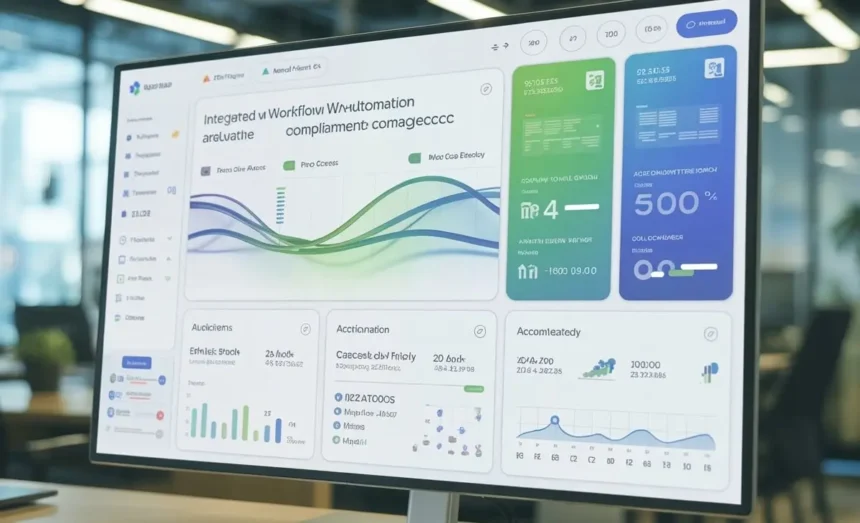Companies are under constant pressure to do more with less – to move faster, reduce errors, and meet strict regulatory standards. This is where the combination of workflow automation software and best compliance management software plays a vital role. Together, they help organizations streamline day-to-day operations while staying compliant with internal policies and external regulations.
By unifying automation and compliance into a single system, businesses can eliminate manual bottlenecks, reduce compliance risks, and gain better visibility across processes. In this article, we’ll explore how this integration works, why it matters, and how it can transform the way your organization operates.
The Need for Unifying Workflow Automation and Compliance
Every organization runs multiple processes daily – from employee onboarding to purchase approvals to vendor management. Traditionally, these workflows involve manual approvals, emails, spreadsheets, and disconnected systems. This not only slows down the process but also makes it difficult to track who did what and when – a serious problem for compliance and audits.
At the same time, regulatory requirements are becoming more complex. Industries such as banking, healthcare, insurance, and manufacturing must follow strict rules around data privacy, documentation, and approvals. Without a unified system, maintaining compliance becomes a full-time challenge.
Integrating workflow automation with compliance management bridges this gap. It ensures every step of the workflow – from data entry to approval – is recorded, auditable, and compliant by design.
Key Benefits of Combining Workflow Automation and Compliance
1. Consistent and Transparent Processes
Workflow automation software brings structure to every process. It ensures tasks follow a consistent path and are performed the same way every time. When compliance checks are embedded into automated workflows, every step is logged and traceable. This creates a clear audit trail — something regulators and auditors love to see.
2. Reduced Manual Errors and Risks
Manual data entry, email-based approvals, or spreadsheet tracking often lead to errors and missing information. Automation reduces these risks by handling repetitive tasks, sending automated alerts, and enforcing mandatory compliance steps. It ensures that no task moves forward without required validations.
3. Real-time Monitoring and Reporting
Modern workflow automation software allows real-time tracking of process status and bottlenecks. When integrated with compliance tools, it provides dashboards and reports that highlight both performance and compliance metrics. This helps compliance officers identify risks early and take corrective action before they escalate.
4. Faster Approvals with Built-in Checks
Automating workflows means approvals are routed automatically to the right people based on predefined rules. For example, a financial transaction above a certain threshold can automatically be routed to senior management for review. When compliance logic is built into these rules, every approval meets company and regulatory standards without manual intervention.
5. Improved Collaboration and Accountability
In a unified system, everyone — from employees to compliance officers — works on the same platform. This transparency improves collaboration while maintaining accountability. Each user’s action is recorded, ensuring that compliance is not just an afterthought but part of the business culture.
6. Better Prepared for Audits
One of the biggest advantages of combining automation with compliance is audit readiness. Since every workflow action is automatically documented, generating audit trails takes minutes, not days. The system ensures records are accurate, time-stamped, and tamper-proof.
How the Integration Works
When workflow automation and compliance systems work together, compliance isn’t treated as a separate task — it’s built into every step of the process.
- Form-Level Validation: Before data is submitted, automated checks ensure that all required fields, documents, and approvals are in place.
- Role-Based Access: Only authorized users can perform certain actions or view sensitive data.
- Automated Alerts and Escalations: If deadlines or compliance rules are missed, the system automatically notifies the right person.
- Audit Trail Generation: Every workflow activity is recorded for future reference.
- Policy Updates: Compliance rules can be updated in the system, instantly reflecting across all workflows.
This integrated setup not only ensures compliance but also keeps processes efficient and up to date with evolving business and regulatory requirements.
Real-World Example
Consider a financial institution managing vendor payments. The workflow includes invoice approval, fund release, and compliance verification. Without automation, this involves multiple emails, paper approvals, and manual record-keeping — a recipe for delays and errors.
By using a unified system that combines workflow automation and compliance management, each stage of the process is automated and tracked. Invoices automatically route to the right approver, compliance documents are verified instantly, and the audit trail is maintained in real time. The result? Faster approvals, fewer compliance risks, and happier auditors.
Conclusion
In the digital era, businesses cannot afford to treat compliance as a separate checklist or automation as a standalone feature. The future lies in systems that unify both — ensuring smooth, fast, and compliant operations.
By integrating workflow automation software with best compliance management software, organizations can create an environment where efficiency and accountability go hand in hand. The result is not just better compliance but also a smarter, faster, and more resilient business.
When compliance becomes part of your workflow — not an afterthought — you gain more than just peace of mind. You gain control, clarity, and the confidence to grow your business without breaking stride.







